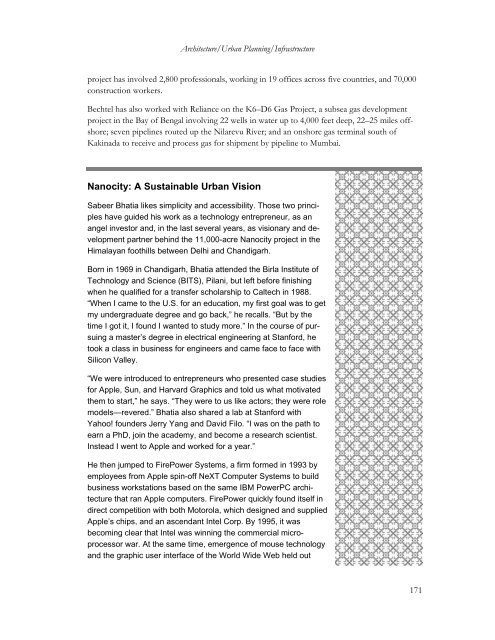PDF: 2962 pages, 5.2 MB - Bay Area Council Economic Institute
PDF: 2962 pages, 5.2 MB - Bay Area Council Economic Institute
PDF: 2962 pages, 5.2 MB - Bay Area Council Economic Institute
Create successful ePaper yourself
Turn your PDF publications into a flip-book with our unique Google optimized e-Paper software.
Architecture/Urban Planning/Infrastructure<br />
project has involved 2,800 professionals, working in 19 offices across five countries, and 70,000<br />
construction workers.<br />
Bechtel has also worked with Reliance on the K6–D6 Gas Project, a subsea gas development<br />
project in the <strong>Bay</strong> of Bengal involving 22 wells in water up to 4,000 feet deep, 22–25 miles offshore;<br />
seven pipelines routed up the Nilarevu River; and an onshore gas terminal south of<br />
Kakinada to receive and process gas for shipment by pipeline to Mumbai.<br />
Nanocity: A Sustainable Urban Vision<br />
Sabeer Bhatia likes simplicity and accessibility. Those two principles<br />
have guided his work as a technology entrepreneur, as an<br />
angel investor and, in the last several years, as visionary and development<br />
partner behind the 11,000-acre Nanocity project in the<br />
Himalayan foothills between Delhi and Chandigarh.<br />
Born in 1969 in Chandigarh, Bhatia attended the Birla <strong>Institute</strong> of<br />
Technology and Science (BITS), Pilani, but left before finishing<br />
when he qualified for a transfer scholarship to Caltech in 1988.<br />
“When I came to the U.S. for an education, my first goal was to get<br />
my undergraduate degree and go back,” he recalls. “But by the<br />
time I got it, I found I wanted to study more.” In the course of pursuing<br />
a master’s degree in electrical engineering at Stanford, he<br />
took a class in business for engineers and came face to face with<br />
Silicon Valley.<br />
“We were introduced to entrepreneurs who presented case studies<br />
for Apple, Sun, and Harvard Graphics and told us what motivated<br />
them to start,” he says. “They were to us like actors; they were role<br />
models—revered.” Bhatia also shared a lab at Stanford with<br />
Yahoo! founders Jerry Yang and David Filo. “I was on the path to<br />
earn a PhD, join the academy, and become a research scientist.<br />
Instead I went to Apple and worked for a year.”<br />
He then jumped to FirePower Systems, a firm formed in 1993 by<br />
employees from Apple spin-off NeXT Computer Systems to build<br />
business workstations based on the same IBM PowerPC architecture<br />
that ran Apple computers. FirePower quickly found itself in<br />
direct competition with both Motorola, which designed and supplied<br />
Apple’s chips, and an ascendant Intel Corp. By 1995, it was<br />
becoming clear that Intel was winning the commercial microprocessor<br />
war. At the same time, emergence of mouse technology<br />
and the graphic user interface of the World Wide Web held out<br />
171








